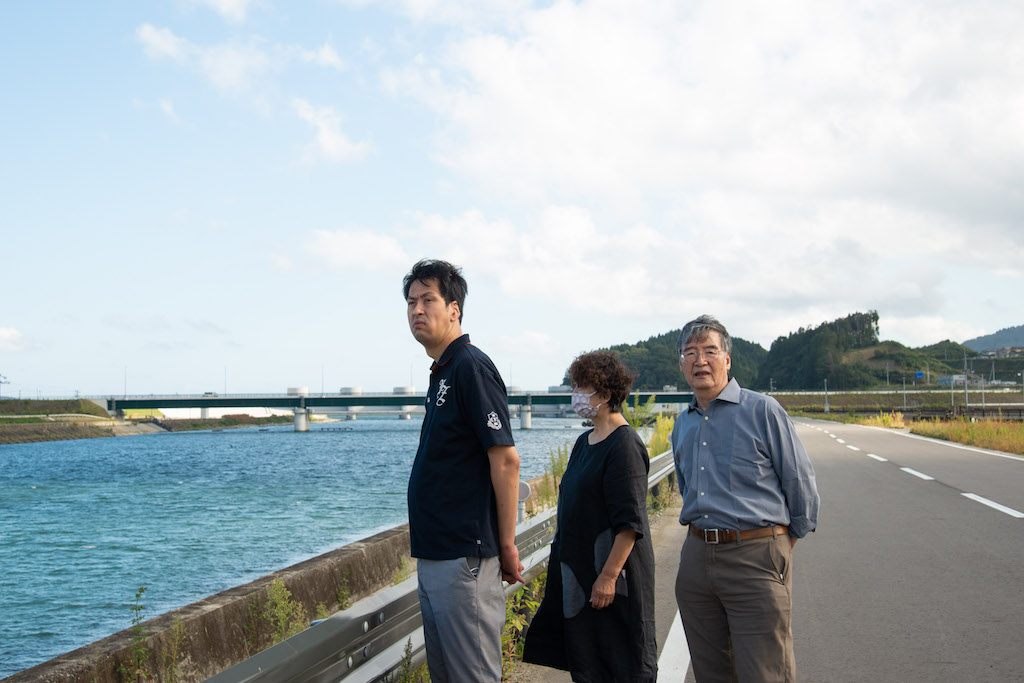このサイトの推奨ブラウザはGoogle Chromeです

令和2年度日本博主催・共催型プロジェクト
日本博を契機とした障害者の文化芸術フェスティバル2020年2月から2022年2月まで
Art Brut CREATION NIppon from 2.2020 to 2.2022
このサイトの推奨ブラウザはGoogle Chromeです

あの日から10年 陸前高田より祈りを込めて
震災後を描き続ける画家・田﨑飛鳥さんのアトリエを訪ねて
Ten Years Later, Prayers from Rikuzentakata
Visiting the studio of Asuka Tazaki, an artist who continues to paint after the earthquake
disaster
宮城県から岩手県へ向かって三陸自動車を北上する。秋晴れの朝、キラキラと輝く海が美しい。気仙沼で2021年3月に開通したばかりの「かなえおおはし」を渡ると間もなく、県境を越え陸前高田市に入った。整備された平らな空き地があちこちにある街を、穏やかな朝の光が照らす。
Driving north on the Sanriku Expressway from Miyagi Prefecture to Iwate Prefecture. On a clear
autumn morning, the sparkling sea is beautiful. In Kesennuma, after crossing the Kanae Ohashi
Bridge, which opened in March 2021, and soon traversing the prefectural border into Rikuzentakata
City. The gentle morning light illuminates the city, which is replete with flat and well-maintained
vacant lots.
10年前、陸前高田市には15mを越える波が押し寄せ、家屋は瓦礫となってあたりを埋め尽くした。2021年3月1日時点で分かっている陸前高田市内の震災での死者は1,559人、行方不明者は202人。
Ten years ago, the city of Rikuzentakata was hit by waves over 15 meters high, and houses were
filled with rubble. As a result, 1,559 people died in Rikuzentakata as of March 1, 2021, and 202
people are still missing.
瓦礫を撤去した後、陸前高田では大規模なかさ上げ工事(盛り土)を実施。2021年春、ようやく工事が終わり、海抜10mの土地に生まれ変わった。現在は商業施設などが続々とオープンして、新たな賑わいが生まれつつある。
After the debris was removed, Rikuzentakata underwent a large-scale construction
(embankment) project. The work will finally be completed, and the land will be reborn 10 meters
above sea level. Currently, commercial facilities are opening one after another, and a new
liveliness is beginning to emerge.
画家・田﨑飛鳥(たざきあすか)さんは、中学生の頃に埼玉県より家族とともに移り住んで以来、ずっと陸前高田で暮らしている。彼の作品には、彼にとって身近な人物や、記憶に残っている自然・生き物がよく描かれる。震災後の作品には、失ったものやこれからへの祈りも込められているという。
Artist Asuka Tazaki has been living in Rikuzentakata since he and his family moved
there from Saitama Prefecture when he was in junior high school. His works often depict people close
to him and nature and creatures that are part of his memory. His post-disaster works are said to
contain his prayers for what was lost and for the future.
「障害者の文化芸術フェスティバル in 東北ブロック」では、田﨑飛鳥さんと、ご家族とともに陸前高田をめぐる映像作品を制作。10月23日(土)に「アイーナ 小田島組☆ほーる」で上映予定だ。
9月某日収録取材が行われ、筆者も同行した。ここでは取材から見えてきた、飛鳥さん自身と、作品のバックグラウンド、そして現在の陸前高田の魅力についてご紹介する。
For the "Art Brut CREATION Nippon in IWATE," Asuka Tazaki and his family made a film about
Rikuzentakata, which will be shown at Aiina Odajima-gumi Hall on Saturday, October 23.
On a certain day in September, a recording session was held, and I accompanied the filmmakers. Here,
I would like to introduce Asuka himself, the background of his work, and the current appeal of
Rikuzentakata, as revealed through the interview.

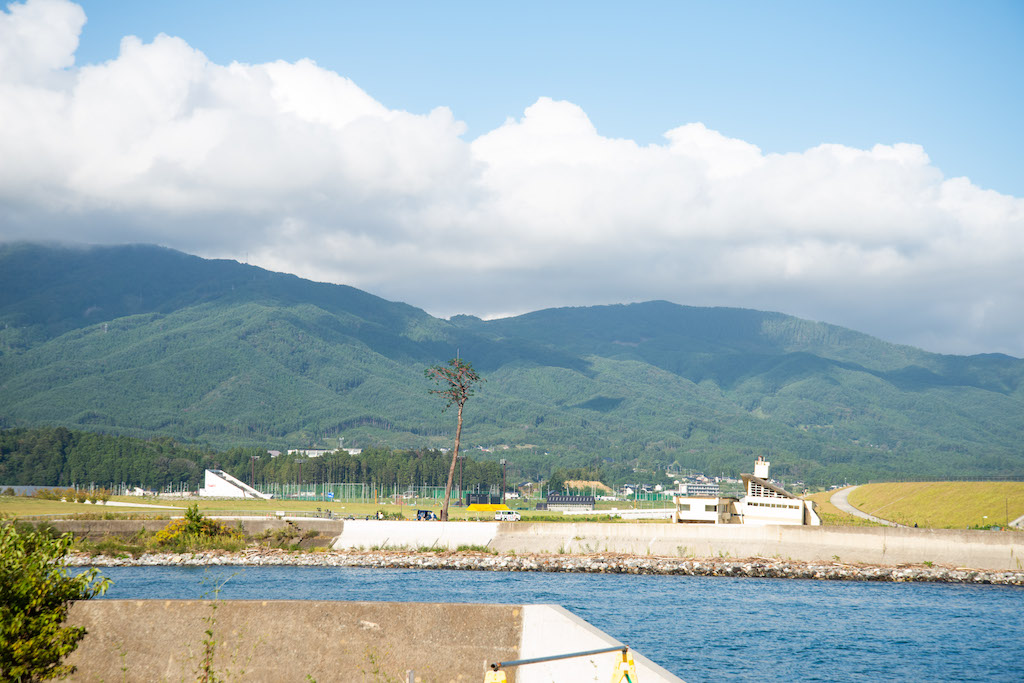
田んぼが広がる静かなアトリエで、週末、集中して絵を描く飛鳥さん
Asuka concentrates on painting on weekends in a quiet atelier surrounded by rice
paddies.
作品の制作は、父・實(みのる)さんとともに、自宅の裏手にある離れの小屋で行う。作業スペースは、彫金師である實さんの仕事場も兼ねていて、室内にはさまざまな道具や資料がびっしりと並ぶ。
Asuka and his father, Minoru, create their works in a remote cabin behind their house. The workspace
also serves as a workshop for Minoru, a metal engraver, and the room is filled with various tools
and materials.
飛鳥さんは描きかけのキャンバスの前に座ると、無数に置かれた絵の具チューブの中からひとつ色を選び、實さんに手渡した。實さんは絵の具を絵皿に出し、水でゆるめて飛鳥さんに戻す。絵皿を受け取った飛鳥さんは、筆を取り、迷うことなくキャンバスに色をのせていく。絵の具をゆるめすぎるとキャンバスに絵の具が垂れてしまうので、飛鳥さんが絵を描くとき實さんがサポートしているそうだ。
Asuka sits down in front of a partially painted canvas, selects a color from one of the
numerous tubes of paint, and hands it to Minoru. Minoru pours the paint onto a plate, loosens it
with water, and returns it to Asuka. After receiving the plate, Asuka picks up a brush and spreads
the color on the canvas without hesitation. Minoru supports Asuka as he paints since the excessive
loosening of the paint will cause it to drip on the canvas.
震災後、海の近くから山間へ自宅とアトリエを移した飛鳥さん一家。辺りには田んぼが広がり、家屋もぽつりぽつりとしかない場所なので、アトリエはとても静かだ。耳に入る音といえば、絵皿のぶつかる音と、遠くで稲を刈る機械の音、風が葉を揺らす音、そしてときどき鳴く猫のレオの声。
After the earthquake disaster, Asuka and his family moved their home and studio near
the sea to the mountains. The studio is very quiet, as the area is surrounded by rice paddies with
only a handful of houses. The only sounds one hears are the clashing of plates, the sound of rice
harvesting machines in the distance, the wind rustling the leaves, and the occasional purr of Leo,
the cat.
飛鳥さんは現在、月曜から金曜まで、陸前高田市の障害者就労継続支援事業所「あすなろホーム」でワカメ加工作業の仕事をしている。そして週末を中心に、こうして絵を描いている。長いときでは、9時から16時くらいまで集中して描くという。アクリル画のほかに、ドローイングを描くこともあるそうだ。
From Monday to Friday, Asuka works as a wakame seaweed processor at "Asunaro Home," a
support center for disabled people based in Rikuzentakata City. On weekends, he paints as such.
During his longer stretches, he paints intensively from 9:00 to 16:00. In addition to acrylic
paintings, he sometimes creates drawings.
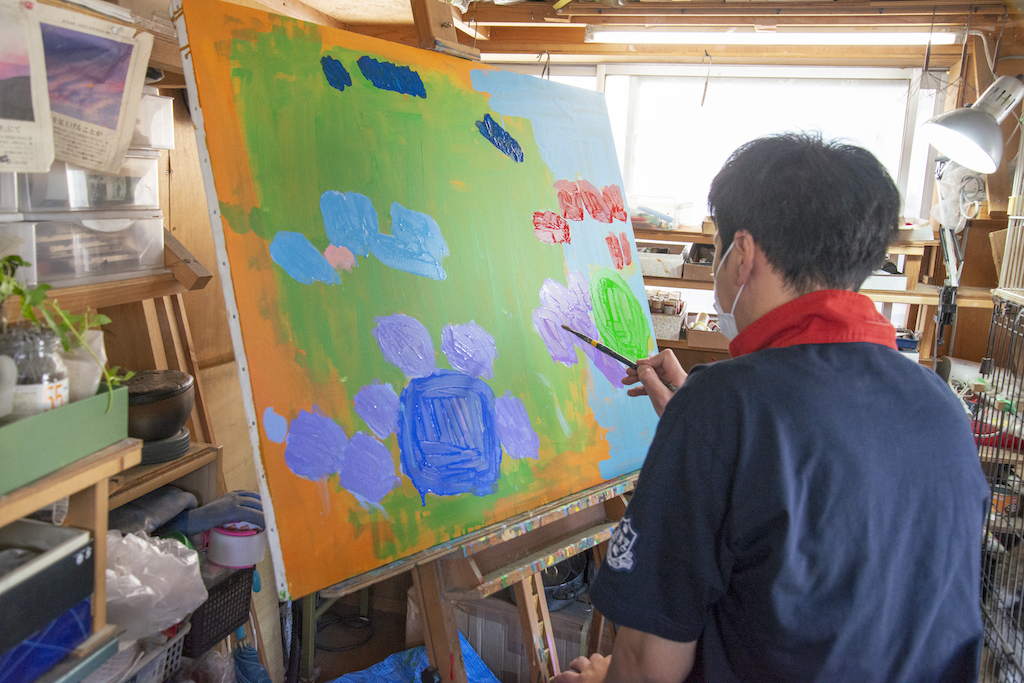
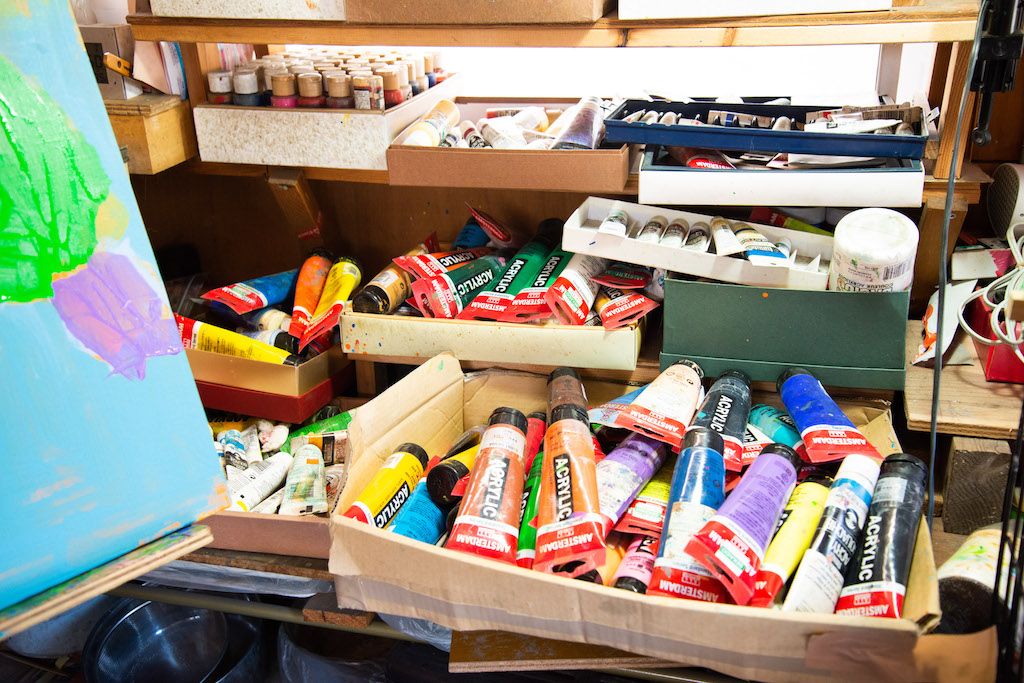
多くを失った震災 父・實さんが見た飛鳥さんの絵の変化
Much was lost from the earthquake disaster The Changes in Asuka's paintings seen by
his father, Minoru
幼い頃から、展覧会の図録に興味を持っていたという飛鳥さん。父・實さんは「感性には絶対に障害はない。感性を使って自己表現してもらいたい」と考え、飛鳥さんに絵を描くことを提案した。
Asuka says that he has been interested in exhibition catalogs since he was a child.
Minoru, his father, said, "There is absolutely no obstacle to sensitivity. I want him to use his
senses to express himself," and he suggested that Asuka draw pictures.
小学生時代までは埼玉県の新座市で過ごした。障害者のグループで絵の先生を招き、小学校低学年の頃から作品制作を始めたという。中学1年生で母・美代子さんの故郷である陸前高田市に移り住んでからも、絵の先生に師事し、制作を続けた。2000年には、「第3回いわて・きららアート・コレクション」優秀賞と「第8回岩手県障害者文化芸術祭」佳作に選出される。しかし、震災前の作品はすべて、津波で流されてしまった。
He lived in Niiza City in Saitama Prefecture until his elementary school days.
After inviting a painting teacher to a group for disabled people he began creating artworks in
the early grades of elementary school. Even after moving to his mother Miyoko’s hometown of
Rikuzentakata City in his first year of middle school, he continued to study under a painting
teacher and created works. In 2000, he received the Excellence Award at the Third Iwate Kirara
Art Collection and an Honorable Mention at the "Eighth Iwate Prefecture Culture and Art Festival
for Disabled People." However, all of his works created prior to the earthquake were washed away
by the tsunami.
震災前は、海の近くの気仙町・今泉地区で暮らしていた飛鳥さん。自宅そばには海へ注ぐ気仙川が流れていた。震災では、自宅をはじめ、近所の家々はことごとく流された。自宅のあった場所に残ったのは瓦礫の山だった。
Before the disaster, Asuka lived in the Imaizumi area of Kesen-cho, near the sea.
Near his house, the Kesen River flows into the sea. Upon the earthquake strike, his and other
homes in the neighborhood were all washed away. All that was left was a pile of rubble where his
home used to be.
震災後しばらく飛鳥さんは絵筆を取ることがなかったが、「展覧会を開くので絵を描かないか」と知人に誘われたのをきっかけに、再び描き始める。しかし飛鳥さんが新たに描いた絵を見て實さんは、「それまでの絵とは異なる、荒々しく激しい絵」だと感じたという。
震災後、最初に描いたのは「星になった人々」という作品。黄色の背景に、青い服を着た6人の人物、そしてそのまわりに花が描かれている。6人の人物は、震災前に暮らしていた地区の町内会で、飛鳥さん一家と同じ班だった方々。震災で亡くなった。
After the disaster, Asuka did not pick up his brush for a while, but he started
painting again when an acquaintance asked if he would paint for an exhibition. However, when
Minoru saw Asuka's new paintings, he felt that they were "wild and violent, different from his
previous paintings.”
The first painting he did after the disaster was called "People Who Became Stars.” The six
people in the painting were members of the same group as Asuka's family in the neighborhood
association where they lived before the earthquake. They died in the earthquake.
實さんが驚いたのは、それまでの作品にはなかった激しい色だ。唇は紫、洋服も全員が青という色使いに、異様さを覚えたという。
震災後しばらくはそのような激しい絵が多かったそうだが、5~6枚描いた頃から以前のような絵に戻ってきたという。「絵は飛鳥にとって気持ちを整理するものなんじゃないかと思う」と實さんは話す。花は、〝天国でみんな楽しく過ごしてるといいね〟という祈りを込めて描いたそうだ。
What surprised Minoru were the intense colors, which were not used in his previous works. Lips
were purple, and clothes were all blue, which he found bizarre.
For a while after the earthquake disaster, Asuka painted many of these intense paintings, but
after five or six paintings, he returned to his previous style. “I think painting is a way for
Asuka to sort out his feelings," said Minoru. He apparently drew the flowers as a prayer, with
the hope that "everyone is having a good time in heaven."
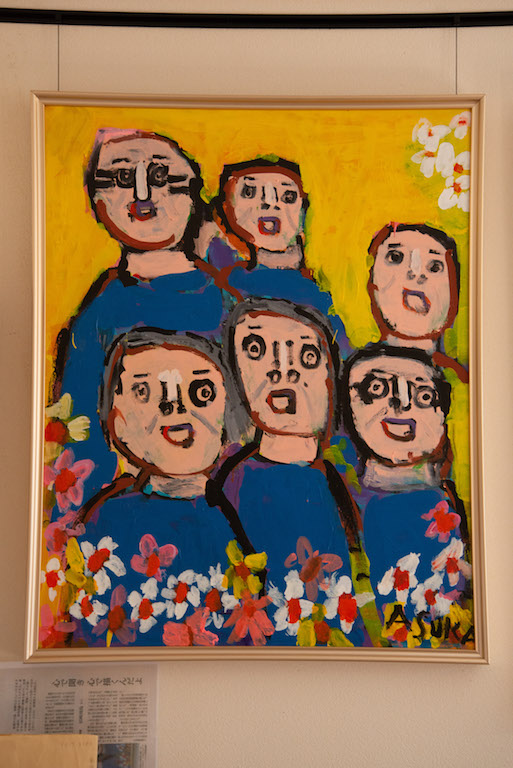
姿を変えた御神木と守り抜いた「喧嘩七夕」
The transformed sacred tree (Goshinboku) and the safeguarded "Fighting (Kenka)
Tanabata"
震災前に暮らしていた地区にまつわる作品はまだある。縦のキャンバスいっぱいに描かれた大樹。これは、以前の家のそばにあった「今泉天満宮」の御神木だ。樹齢800~1000年と推定される立派な杉だったが、津波による被害で、震災後間もなく伐採が決まった。
There are more works related to the area before the earthquake. A large tree fills the
vertical canvas. This is the sacred tree of Imaizumi Tenmangu Shrine, which was located near the old
house. It was a magnificent cedar tree, estimated to be 800 to 1,000 years old, but due to the
damage caused by the tsunami, the decision was made to cut it down soon after the earthquake.
飛鳥さんは、一枚の絵を描く過程で、全く別の色を重ねていくことがあるそうだが、御神木の絵に関しては、「はじめは杉の怨念が伝わってくるような激しい色だった」(實さん)そうだ。しかし次第にカラフルになり、最後は青々とした葉も加わった。絵を鑑賞する多くの人が、木の生命力を感じると口にする。
In the process of painting a single picture, Asuka sometimes adds layers with entirely
different colors, and as for the sacred tree painting, "At first, the colors were so intense that
you could feel the grudge of the cedar," says Minoru. Gradually, however, they became more colorful,
and in the end, lush leaves were added. Many people who appreciate the paintings say that they feel
the life force of the trees.

飛鳥さん一家が以前暮らしていた今泉地区にも訪れた。今泉天満宮には、伐採された後の御神木の幹と、2021年6月に完成したばかりの新しい社殿が建つ。「今はかさ上げされて周りの土地が高くなったけど、前はこの天満宮が町よりも高台にあったんだよ」と實さんが教えてくれた。
I also visited the Imaizumi area where Asuka and his family used to live. At
Imaizumi Tenmangu Shrine stands the trunk of the sacred tree after it was cut down and the new
shrine building, just completed in June 2021. Minoru mentioned, "The land around the shrine has
been raised, but it used to be on higher ground than the town."
今泉天満宮はこの地区の人々にとってはとても身近な存在だ。陸前高田の夏の祭りといえば、飛鳥さんたちが暮らしていた気仙町の「喧嘩七夕」と、高田町の「動く七夕」。いずれも夏の一大行事で、地元の方が祭りにかける思いは熱い。
Imaizumi Tenmangu Shrine is very well known to the people of this area. The summer
festivals in Rikuzentakata are the "Fighting Tanabata" festival in Kesen-cho, where Asuka and
his friends lived, and the "Moving (Ugoku) Tanabata" festival in Takada-cho. Both are major
summer events, and the local people are passionate about their festivals.
毎年8月7日に行われる「喧嘩七夕」は、気仙町の4町内会が、短冊や吹き流しなどで飾った山車を繰り出し町内を回ったあと、山車をぶつけ合い、勝敗を競う。
In the "Kenka Tanabata," held every year on August 7, four neighborhood
associations in Kesen-machi parade mountain carts (yama-guruma) decorated with poems on paper
strips and wind streamers and go around the town. A competition is held by colliding the
mountain carts together.
飛鳥さん一家が所属していた町内会の山車は、他の町内会の山車3台と合流して出発する。飛鳥さんも祭りの日に山車を見に行ったという。
The mountain cart of the neighborhood association to which Asuka's family belongs
joins three other carts of neighboring associations and depart. Asuka also went to view the
floats on the day of the festival.
震災では祭りに使う道具や山車、そして祭りを盛り上げる仲間を失った。祭りが途絶えてもおかしくない状況だったが、残った山車1基で2011年も祭りを開催。地域を勇気づけた。その翌年には、山車もう1基を組み上げ、2基でぶつけ合う「けんか」が復活を遂げた。
From the earthquake disaster, the tools used for the festival, the floats, and the
friends who made the festival so exciting were lost. That could have been the end of the
festival, but they held the festival again in 2011 with the one remaining cart. The following
year, a new cart was built, and the "kenka" (fighting), in which two floats collide, was
revived.


作品に込められた飛鳥さんの心 気仙中学校と一本松
Asuka puts his heart in his work: Kesen Junior High School and a lone pine
tree
今泉地区を巡った後、かつて飛鳥さんと、母・美代子さんが通ったという、気仙中学校を訪れた。気仙中学校のある一帯は「高田松原津波復興祈念公園」として整備されている。気仙中学校をはじめ、「奇跡の一本松」や「陸前高田ユースホステル」などは、震災遺構として保存されており、誰でも見学が可能だ。(校舎内の見学はツアー等でのみ可能)
2011年3月11日、気仙中学校では3階建て校舎の屋上よりさらに上まで津波が到達した。窓ガラスは割れ、教室は破壊された。不幸中の幸いだったのは、気仙中学校では誰も犠牲にならなかったことだ。普段から近くの高台へ逃げる避難訓練を行っていたためだった。
After touring the Imaizumi area, I visited Kesen Junior High School, where Asuka and his mother
Miyoko once attended. The area where Kesen Junior High School is located is developed as the "Takada
Matsubara Tsunami Reconstruction Memorial Park”. In addition to Kesen Junior High School, the
"Miracle Lone Pine Tree" and the "Rikuzentakata Youth Hostel" have been preserved as the remains of
the earthquake disaster and are open to the public. (The interior of the school building can only be
visited on tours.)
On March 11, 2011, the tsunami reached further than the roof of the three-story school building at
Kesen Junior High School. Windows were broken, and classrooms were destroyed. It was fortunate that
no one was killed at Kesen Junior High School. This was because they had been practicing evacuation
drills to escape to nearby high ground.

「奇跡の一本松」は、かつて日本百景にも数えられていた美しい松林「高田松原」のたった一本の生き残りだ。しかし海水によるダメージは深刻で、やがて枯死が確認されると、倒れ朽ちてしまう前に保存プロジェクトが立ち上がった。現在私たちが「奇跡の一本松」を見ることができるのは、基礎をコンクリートにするなど、補修をおこなったためだ。
気仙中学校と、一本松にまつわる飛鳥さんの作品がある。海を見つめる4羽のウミネコと、ピンク色の背景が印象的な一本の松の絵だ。
The "Miracle Lone Pine Tree" is the sole survivor of "Takada Matsubara," a beautiful pine forest
that was once one of Japan's top 100 scenic spots. However, the damage caused by the seawater was so
severe that it was eventually confirmed to be dying, and a preservation project was launched to save
it before it collapsed and decayed. We can see the "Miracle Lone Pine Tree" today because the
foundation was replaced with concrete, and other repairs were made.
There is a work by Asuka related to Kesen Junior High School and the lone pine tree. It is a picture
of four black-tailed gulls staring at the sea and a pine tree with an impressive pink background.
河口付近に建つ気仙中学校は、毎日のようにウミネコがベランダへ遊びに来る学校だった。飛鳥さんが中学生の頃、遊びに来るウミネコの中に一羽だけ、片足がないウミネコがいたそうだ。實さんはウミネコと飛鳥さんのつながりについてこう語る。「当時クラスメイトだった女の子が、弁論大会でその片足のウミネコについて話をしてくれたんです。その後に『私たちの仲間にも障害を持つ人がいます』と、飛鳥のことを話してくれた。みんなが飛鳥のことを受け入れてくれていた、という飛鳥にとって大切な思い出なんです」。
Kesen Junior High School, built near the mouth of the river, was a school where black-tailed gulls
came to play on the balcony every day. When Asuka was in junior high school, there was only one
black-tailed gulls that came to visit, and it was missing one leg. Minoru explains the connection
between the black-tailed gulls and Asuka. "A girl who was his classmate at the time told me about
the one-legged petrel at an oratorical contest. Afterward, she recounted about Asuka, saying, 'Some
of my friends have disabilities, too’. It was an important memory for Asuka that everyone accepted
him."
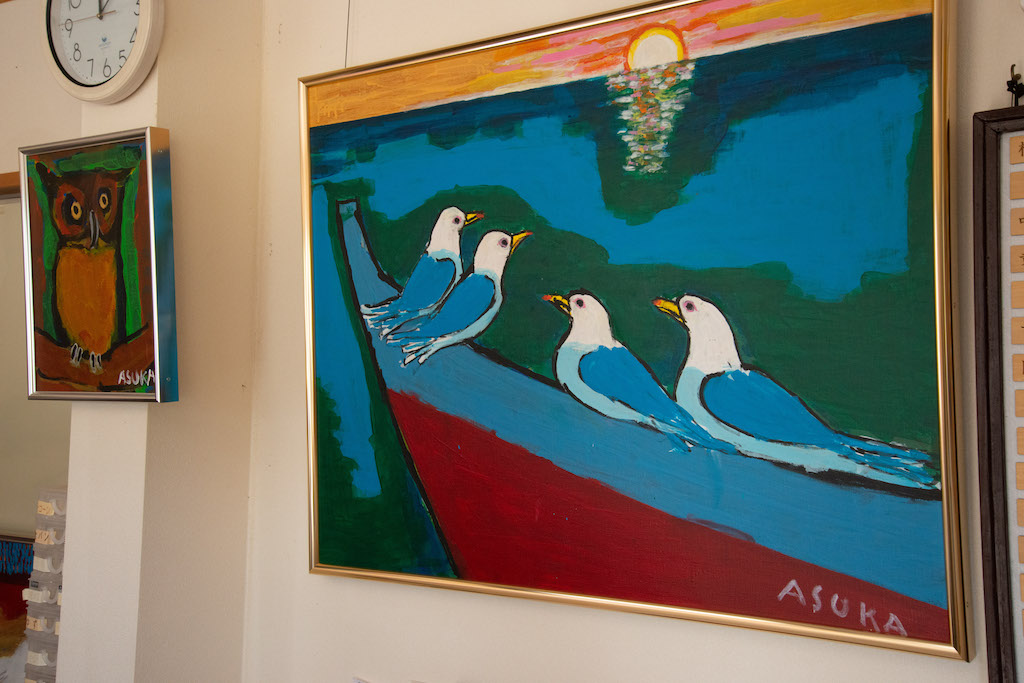

一本松の絵は、アトリエに展示されている絵の中では、やや暗いトーンの作品だ。青い海を背に、すっと立つ一本の松。背景は黒や紫を下地に、赤や黄、橙が塗り重ねられている。全体的に重い印象の背景の中で、葉の緑と、葉を縁取るように入れられたピンクが際立つ。
The painting of the lone pine tree has a slightly darker tone than the other paintings displayed in
the studio. A lone pine tree stands straight up against the blue sea. The background is black and
purple, with red, yellow, and orange painted over it. The green leaves and the pink bordering the
leaves stand out against the overall heavy impression of the background.
震災後、比較的早い時期に描かれたというこの作品。震災後しばらくは海の近くへ行くことに恐怖を覚えていた飛鳥さんだったが、一本松の近くを通るたびにそちらに目を向けていたので、實さんが「絵に描いてみたら?」と提案したそうだ。
This work was painted relatively early after the earthquake. For a while after the disaster, Asuka
was afraid to go near the sea, but every time he passed by the lone pine tree, he kept looking in
that direction, so Minoru suggested, "Why don't you paint it?"
激しい色使いの作品の中で、ひとつ気になる箇所がある。向かって左側、松の葉のあたりから、ピンク色が下に伸びている部分だ。アトリエに訪れる鑑賞者も同じことを感じるようで、ある人は實さんに「松の木が『さよなら』と言って涙を流しているみたいだね」と話してくれたそうだ。
There is one part of the intensely colored work that is attention-drawing. On the left side of the
painting, the pink color extends downward from the pine leaves. Visitors to his studio seem to feel
the same way, and one of them told Minoru, "It looks like the pine tree is saying 'goodbye' and
shedding tears."
市役所新庁舎での展示とシンガポールとのつながり
The exhibition at the new Rikuzentakata City Hall and its connection with Singapore
飛鳥さんは現在、陸前高田市役所新庁舎で行われる展示に向け、作品を制作中。市役所旧庁舎は津波で全壊し、大勢の方が亡くなった。震災後は長らく仮庁舎を使用していたが、2021年5月6日に新庁舎が開庁。7階建てで木材がふんだんに使われたモダンな庁舎だ。1階には市民交流スペース、7階には展望ロビーがあり、誰でも利用できる。7階の展望ロビーでは陸前高田の街並みと広田湾が一望できる。窓のそばに展示されているパネルで、震災前後の航空写真を見比べることもできる。
Asuka is currently working on a piece for an exhibition at the new Rikuzentakata City
Hall building. The old city hall building was completely destroyed by the tsunami, and many people
died. After the earthquake, a temporary government building was used for a long time, but the new
government building opened on May 6, 2021. The seven-story building is a modern building constructed
with a lot of wood. The citizen exchange space is on the first floor, and an observation lobby on
the seventh floor is open to everyone. From the observation lobby on the seventh floor, one can view
the city of Rikuzentakata and Hirota Bay and compare aerial photographs taken before and after the
earthquake on the panels displayed near the windows.
1階の展示スペースで飛鳥さんの作品を展示することが決まった。「作品へは、亡くなった方々への祈りを込めているので、市民のみなさんも見てもらいたい」と實さんは話す。
A decision was made to display Asuka's works in the exhibition space on the first
floor. Minoru said, "We would like the public to see his work, as it incorporates prayers for those
who died."
また、国を超えたプロジェクトも進行中だ。飛鳥さんとあすなろホームの利用者、飛鳥さんをはじめとする陸前高田市の方々、そしてシンガポールの障害者が共同でひとつの作品を制作する。タブレット端末を使い、ひとりひとりが描いた作品データを高田高校の生徒がひとつにまとめ上げるという。
A project that transcends national borders is also underway. Asuka and the users of
Asunaro Home, the people of Rikuzentakata City, and the disabled people of Singapore will
collaborate to create a single work. Using tablet devices, the students of Takata High School will
compile the data from each person's drawings into a single workpiece.
山の恵み・海の恵みとユニークな建築物
Blessings of the Mountains, the Sea, and Unique Architecture
飛鳥さん一家との取材では、陸前高田の食が話題に上ることもあった。実は飛鳥さんのアトリエは、母・美代子さんのパン工房「母笑(ががにこ)」も兼ねている。「母笑」のパンに使われるのは、自宅周辺で採れたヨモギや、陸前高田の野菜、フルーツ。
During our interviews with Asuka and his family, the subject of food in Rikuzentakata came up. In
fact, Asuka's studio also serves as his mother Miyoko's bakery, "Gaganiko”. The bread at Gaganiko is
made with mugworts from the area around their home, vegetables from Rikuzentakata, and fruits.
海の幸のイメージがある陸前高田だが、りんごやゆずの生産も盛んだ。岩手県の中でも比較的温暖な気候の陸前高田は、柑橘類の生産に適しており、日本最北のゆず生産地。そこで採れるゆずは「北限(ほくげん)のゆず」と呼ばれている。飛鳥さんが勤務している「あすなろホーム」で作る「北限のゆず」を使ったシフォンケーキは、爽やかなゆずの香りが上品に香る。
Although Rikuzentakata is often associated with seafood, it also produces apples and Japanese
citrons (yuzu). Rikuzentakata, with its relatively mild climate, is well suited for citrus
production and is the northernmost yuzu-producing area in Japan. The yuzu produced there is called
"Yuzu from the northern limit (Hokugen no Yuzu)". The chiffon cakes made at Asunaro Home, where
Asuka works, are made with "Yuzu from the northern limit" and emanates the elegant aroma of fresh
yuzu.
海の幸では、ワカメやホタテ、カキ、エゾイシカゲ貝が特産。広田湾では養殖産業も復興が進んでいる。
As for seafood, wakame seaweed, scallops, oysters, and Ezo ishikage clams are local specialties. The
aquaculture industry in Hirota Bay is also undergoing reconstruction.
エゾイシカゲ貝(イシガキガイ)は寿司ネタなどに使われる大ぶりの二枚貝だが、日本では陸前高田産のものしか流通していないのだとか。広田湾で採れるカキは、豊洲市場でも一番高値がつけられる。これは広田湾は湾が大きく静かで、台風の影響を受けづらいため。通常、カキの養殖期間2年のところ、広田湾では3年育てることができるから、大きく育つ。これら陸前高田の恵みは、市内の飲食店で味わえる。
The "Cardium californiense" clams (Ezoishikaze-kai or Ishigaki-gai) are large double-shelled clams
used for sushi, but those from Rikuzentakata are the only ones available in Japan. Clams from Hirota
Bay fetch the highest price in the Toyosu market. This is because Hirota Bay is a large, quiet bay
and is not easily affected by typhoons. Normally, clams are cultivated over two years, but in Hirota
Bay, they can be grown over three years, which allows them to grow bigger. These seafood blessings
of Rikuzentakata can be enjoyed at restaurants in the city.
内陸部には昔からの飲食店も多く残る一方、かさ上げ工事が完了した沿岸部には新たなお店や施設が次々とオープンしている。
While many old restaurants remain in the inland areas, new restaurants and facilities are opening in
the coastal areas where the elevation work has been completed.
その中で時折、「おっ」と思うようなユニークな建築物と出合うことがある。隈研吾氏による「まちの縁側」(観光案内所)や、伊東豊雄氏による「交流施設 ほんまるの家」など。
From time to time, I come across unique buildings that make me think, "Whoa." For example, Kengo
Kuma's "Town Edge" (tourist information center) and Toyo Ito's "Exchange Facility Honmaru House."
陸前高田を含む岩手の気仙地区には、江戸時代から「気仙大工」と呼ばれる大工集団がいた。民家はもちろん寺院や建具など何でも造ってしまう職人たちだったそうだ。彼らは関東大震災後の東京の復興でも活躍したそうだ。
In the Kesen area of Iwate, which includes Rikuzentakata, there has been a group of carpenters
called "Kesen carpenters" since the Edo period. They were craftsmen who built houses and temples,
fittings, and anything else that could be conjured. They were also active in the reconstruction of
Tokyo after the Great Kanto Earthquake.
このような背景から、「建築」は陸前高田のアイデンティティのひとつとなっている。新たな名建築が数多く生まれたのも、建築に対する感度が高い土地だったから、という理由があるかもしれない。ちなみに気仙大工にまつわる建築や資料は「気仙大工左岸伝承館」で見ることができる。
Against such a backdrop, the "architecture" has become a part of Rikuzentakata's identity. Many new
masterpieces of architecture have been built in Rikuzentakata, perhaps because the area has a high
sensitivity to architecture. By the way, the architecture and materials related to Kesen carpenters
can be seen at the Kesen Carpenter's Left Bank Tradition Museum.


「どうか長く記憶に」この地で表現し続ける
Continuing to express in this place, "Retaining in memory for a long time"
復興が進み、観光施設や震災遺構も整ってきた陸前高田。飛鳥さんの作品と、そのバックグラウンドを通してこの地を見つめると、「被災地」という大きな枠組みでなく、飛鳥さんとその周囲という、パーソナルな範囲で捉えることができる。
With the reconstruction of Rikuzentakata progressing, the tourist facilities and the remains of the
disaster are now set up. Observing the area through Asuka's works and his background, we can see it
not within the larger framework of the "disaster-stricken area," but rather within Asuka's personal
scope and surroundings.
實さんは取材の終わりに現在の思いを語ってくれた。「震災で大きなものを失いました。みなさまの支援のおかげでなんとか立ち上がれましたが、未だに大きな傷を負っている人もいて、今なお行方不明の人がいる。震災から10年が経ち、街は整ってきました。次第に忘れられていくのを感じますが、どうか長く記憶に留めておいてほしい」。障害を持つ方に対しては「障害者はどうしても孤立してしまいがちです。孤立する前にみんなで繋がっていけたら」とメッセージを残した。
At the end of the interview, Minoru shared his present thoughts. "A lot of things were lost in the
earthquake. Thanks to everyone's support, we were able to get back on our feet, but there are still
people who are badly affected, and there are still people who are missing. Ten years have passed
since the disaster, and the city is recovering. I feel that the city is gradually being forgotten,
but I hope that people will remember it for a long time. As for disabled people, he left the
following message: "Disabled people tend to be isolated. I hope we can all connect with each other
before we become isolated."
取材では、實さん・美代子さんの力強く温かな眼差しと、飛鳥さんの家族や周囲の仲間を信頼している様子が印象的だった。飛鳥さんは最後に、「絵は好きか」という問いに対して、迷うことなく「大好き」という答えを残してくれた。
During the interview, I was impressed by the intense and affectionate eyes of Minoru and Miyoko and
Asuka’s trust towards his family and surrounding friends. When asked if he liked painting at the end
of the interview, Asuka answered without hesitation, "I love it."
